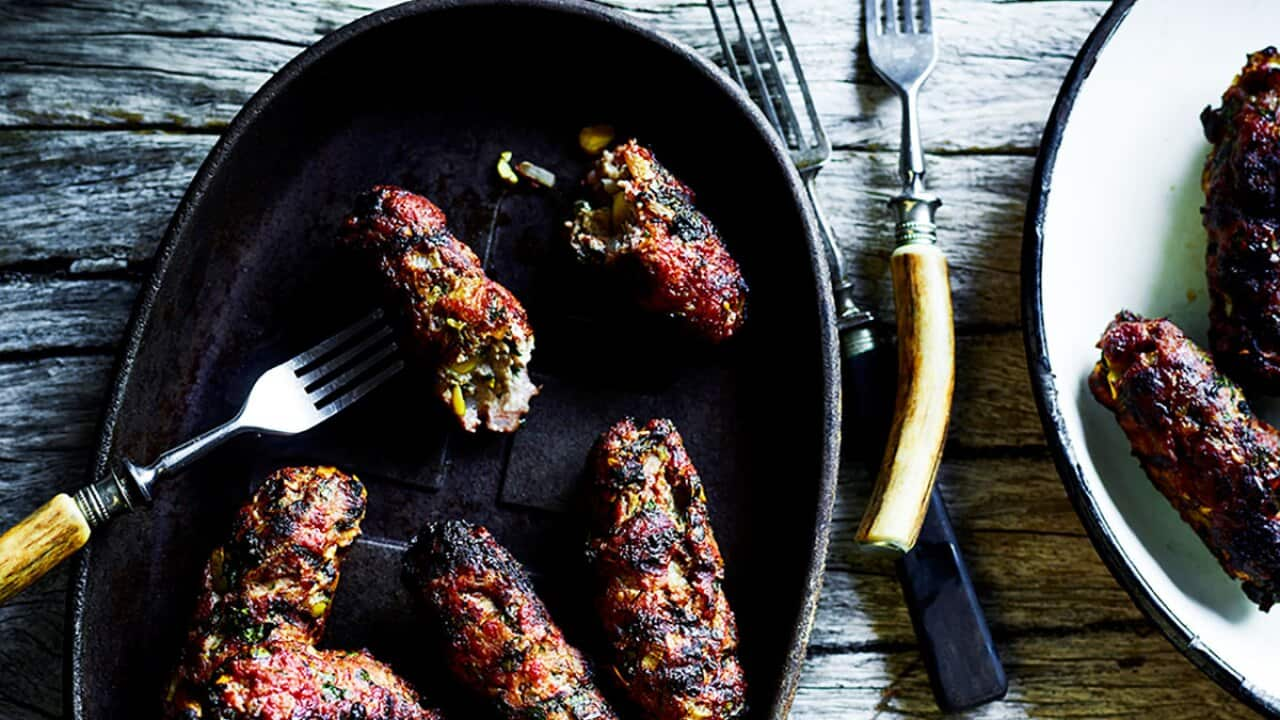--- Diana Chan is bringing the wonder of Asian cuisine to your homes in the second series of , Thursdays at 8pm on SBS Food and streaming on SBS On Demand. ---
It’s hard to imagine an aroma that evokes Chiang Mai, quite like sai oua. In Thailand’s mountain-bound northern capital, this much-loved sausage is lovingly grilled and served, chopped, in plastic bags by street vendors. It hangs in shops and sits, coiled, at markets alongside vats of nam prik noom, a relish made from roasted green chilli. Cross one of the temple-lined streets, or sois, that line the Old City and chances are you’ll smell the sizzle of ground pork hitting the skillet and the scent of its defining ingredients — lemongrass, makrut lime leaves, turmeric, galangal and chilli — in the air.
Sai oua originated in Laos and northeast Burma and was popularised in the US by the likes of Pok Pok, the cult Portland restaurant founded by chef Andy Ricker. In Australia, the wildly herbaceous sausage — which is not to be confused with sai krok isan, a fermented counterpart made with pork and rice and eaten with raw cabbage — has thrived in the home kitchens of Thai immigrants.
It has also increasingly appeared on local menus thanks to a wave of Thai-Australian restaurateurs’ intent on sharing the flavours with which they grew up.
Sai oua was a regular fixture of Palisa Anderson’s childhood diet. Anderson, who’s the founder and owner of and Jarern Chai, an all-day restaurant and store in Sydney’s Thaitown, says that the sausage was her gateway to enjoying more fiery food.
“When you’re a kid, you don’t want to eat the hot stuff but the sausages are so tasty, even my kids love them,” she tells SBS. “You taste the aromatics first and it’s this orchestra of flavours. But the chilli is the high note and you don’t understand that you’re eating it until after you already have. It’s spicy because the fat from the pork carries that chilli and makes it last longer. It’s so flavoursome.”
Visiene Matharu is the co-founder of , restaurant in Parramatta that specialised in Lao dishes and isaan cuisine from north-eastern Thailand. , but a selection of dishes are available at Thai Garden House Restaurant. Matharu had opened the eatery in November 2016, along with her brother, chef Salong Khammountry. She says that although sai oua is considered a staple in Northern Thailand, it was once only relegated to special occasions, especially in villages where there was often a shortage of pork.
“We’re half Thai, half Laotian and find it hard to find that kind of food so we took the opportunity to showcase our heritage and open Lao Der,” she says. “Sai oua used to be a special dish but now it’s served in most homes in Laos and north-eastern Thailand, usually with staples like sticky rice. Sai refers to intestine and oua, the method of making it. At Lao Der, we use fresh coriander, galangal and we make our own curry paste. We also don’t use much fat.” For Clare Ng, preparing sai oua with her mother, Thidarat Ng, the founder of Haymarket’s , has always been family ritual.
For Clare Ng, preparing sai oua with her mother, Thidarat Ng, the founder of Haymarket’s , has always been family ritual.

Northern Thai sausage (Sai oua) Source: Andrew Dorn
“We used to eat sai oua when we were little with our family friends,” she recalls. “When we were older, mum bought a sausage gun and we’d make them at home, together. We’d also prepare them to sell them at the food fairs in Darling Harbour to raise money for the Thai Welfare Association.”
At Boon Café, Anderson makes sai oua from scratch using fresh curry paste and real intestines — a labour-intensive process. Her passion for the dish means that it appears in as many guises as possible — in fusilli pasta and sandwiched between sourdough, and also crowning a brown rice bowl alongside a pickled cabbage salad and soft-boil egg.
“One of my favourite memories is being a first-year uni student visiting Chiang Mai and going to the markets during the day for sai oua,” she recalls. “It’s just tastes so good.”
Lead image by






